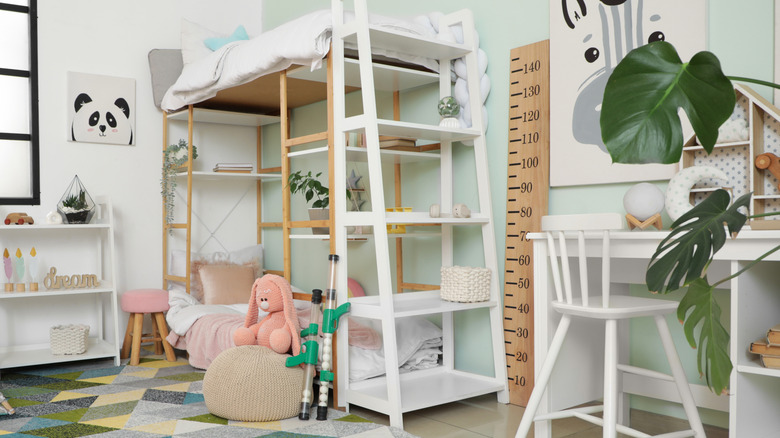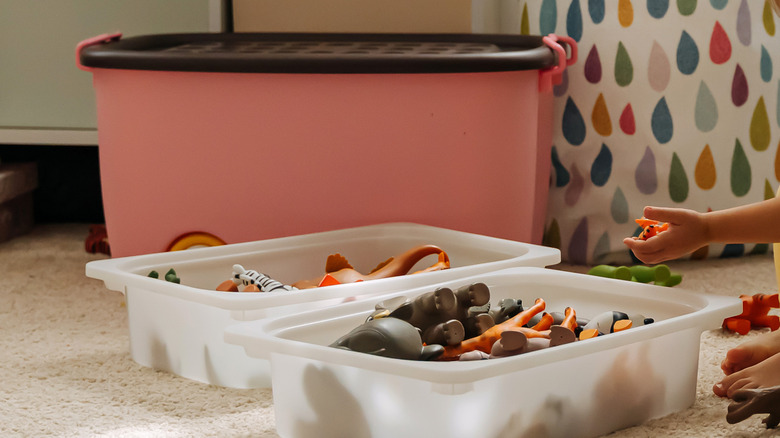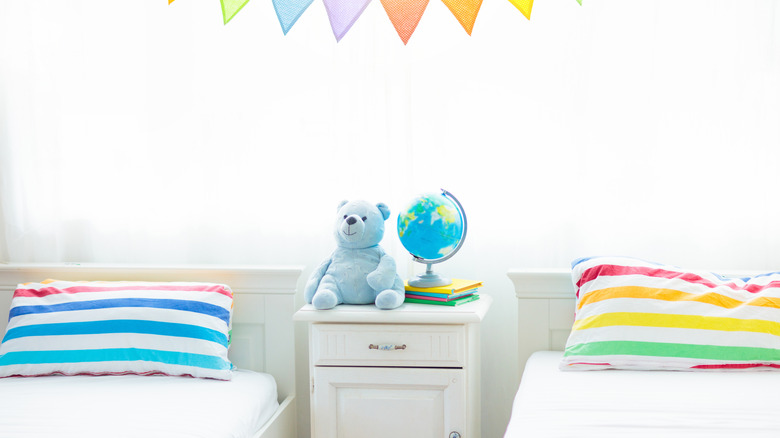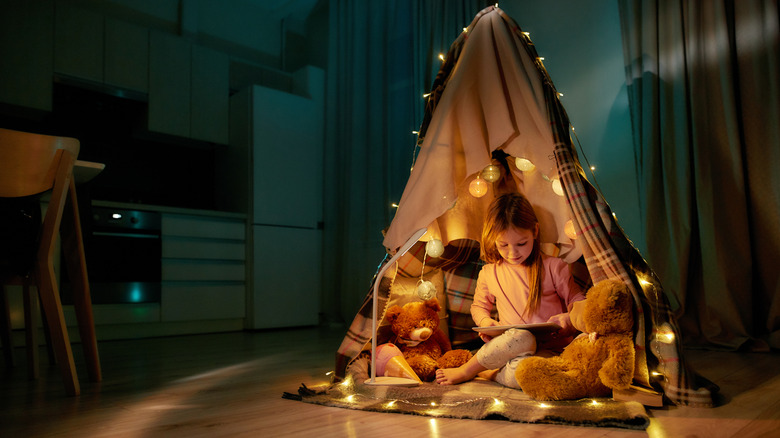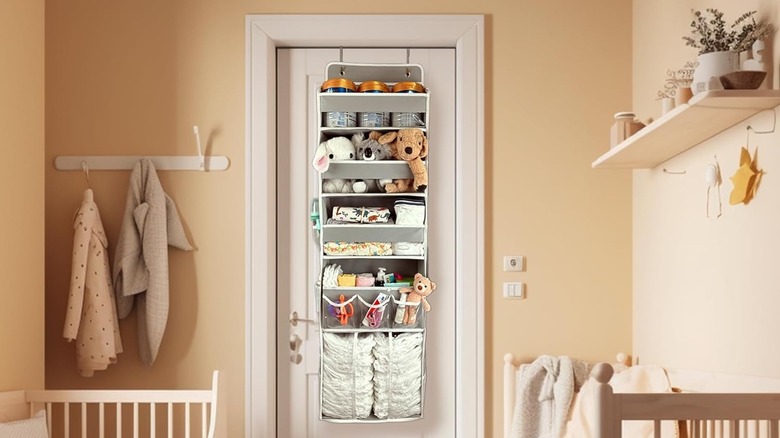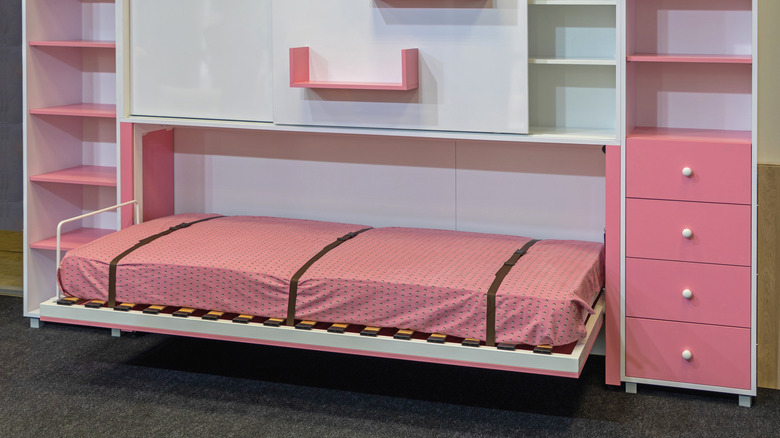Say Goodbye To Clutter: 12 Smart Tips And Tricks To Organize A Shared Bedroom
We may receive a commission on purchases made from links.
Sharing a bedroom is a rite of passage for many children, particularly those in households that are too small to allow for a room each. However, as is the way with children, belongings can quickly pile up. Whether it's birthday presents from friends and family, clothes from doting grandparents, or drawings brought home from daycare, keeping things organized in a shared bedroom can quickly prove difficult.
Fortunately, with a considered approach to organization and some nifty tricks to help maximize on space, it's quite possible to keep even the smallest shared bedroom neat (ish) and as free of clutter as is possible with youngsters. From assessing the layout and available space in your room and ensuring you regularly re-home unused items, to sourcing color-coded storage solutions and furniture that provide space to store clothes and toys, this guide covers everything you need to know. If you're struggling to keep on top of your kids' shared bedroom, then the following tips and tricks to organize a shared bedroom are sure to help you take back control.
Assess the layout and essential items
The organization solutions you choose to adopt in your shared bedroom will be largely dependent on the room's size and shape. One of the biggest mistakes you can make when decorating your kids' bedroom is not maximizing the available space, and you can only do this effectively once you're armed with its measurements. So, before you go ahead and start sourcing storage and furnishings, break out your measuring tape and take stock of the space you have to play with. Also take stock of your kids' toys, clothes, and other belongings, which will help to give you an idea of what you need to store.
Upon measuring the space, you might find that there's plenty of room for twin divan beds, a large storage chest per child, and a desk, with room to spare. On the other hand, you may find that you simply don't have the floor space to accommodate your "ideal" number of storage solutions. Sure, it would be nice to have a box or a drawer for every single toy, book, and garment, but if you only have a small amount of floor space, then you risk cramping and cluttering the room with furniture.
Routinely declutter and rehome unused items
The key here is not just to declutter once, but to form a habit. In kids' bedrooms, things inevitably become disorganized when clutter is allowed to gather, which anybody with kids knows can happen in the blink of an eye. Whereas an adult bedroom may only need a good decluttering once every few months, the rate at which children grow out of things and assume new interests demands a more regular schedule. This is especially true if you have two children sharing, and if this is the case, regularly decluttering can be one of the most creative ways to achieve more storage space in your children's room.
So, with clothes, aim to adopt a "one in, one out" policy. This can ensure that your kids' drawers aren't filled to literal bursting with clothes that they either no longer wear, no longer fit into, or that are damaged beyond repair. Clothes in better condition will be a welcome donation at your local charity store. The same can be said for any damaged clothes that you're able to mend. The other thing to keep on top of is toys, and the same policy can apply to those. You may be loath to donate what used to be their favorite toys, but the truth is that if they no longer use them, then all they're doing is taking up space. As for those that you keep, if your kids like to take a toy to bed with them, then try to enforce a one in, one out policy for those, too. If one of your children decides one evening to take Mr. Snuggles to bed with them, then kindly ask them to pop Mrs. Potato Head back in the downstairs toy chest.
Incorporate large storage units
In a bedroom occupied by just one child, organization is critical to maintain order among their many and varied clothes, toys, books, and bedding. It's doubly important in a shared bedroom. For this reason, quality storage will quickly become your most trusted friend and ally. There are many storage solutions available to suit the room's shape and size; however, in a shared bedroom, you'll want to ensure that you get as much "bang for your buck" from each piece of furniture as possible.
If you're limited on space, then this SpaceAid toy storage organizer is a great solution. It comes with six shelves and no fewer than 12 bins, in which your kids can easily store all of their toys and books. If you have more space, then you could always opt for two. Or you could buy each child a large toy chest apiece. Whichever solution you choose, try to give yourself some growing room. Kids regularly acquire new toys as their interests change, so having a little more storage than you currently need might help to mitigate against mess until you next have a chance to declutter.
Color code your children's spaces
Assuming that they don't share the same favorite color, this one should be easy. Of course, you may not have much choice as to the color of the toys they want to play with. However, you can easily buy storage solutions that are colored to suit each individual child. Even if their preference is more thematic than color-based, that's fine. Again, the best theme for your kids' room will depend on their personal taste. The important thing is to make it as intuitive as possible for your kids to clear up their mess.
For example, perhaps one of your children is absolutely obsessed with dinosaurs. If so, you could indulge their penchant for paleontology with a Jurassic-themed toy chest. Equally, if one is more interested in the cosmos, then a space themed, rocket-shaped stuffed animal organizer is sure to do the trick. If you can also color- or theme-code their clothing chests and laundry bins, then perfect. Personalizing the storage for each child will help them get more interested in cleaning up their own clutter and taking responsibility for their space.
Make clean-up more streamlined with visual divisions
The last thing you want to do is breed resentment between your kids because you gave one more space than the other. More than that, by visibly dividing the room and designating them one half apiece, you can make tidying easier for your kids, and you can make it fair. By clearly designating them a side of the room each, each child will be responsible for their own half of the room, instead of one child receiving a telling-off because the other failed to pull their weight. As for how to divide the room, you could simply draw a "line in the sand." For example, if you're planning to color-code each side of the room anyway, then you could run a line of colored hook-and-loop carpet tape down the center of the room.
You could also use a screen, or hang a drape or curtain from a drapery pole. This method will also give your kids the option of privacy and time to themselves. As for the color you go for, try not to create a confused, disordered color scheme, as this can cause irritability in children. Light green and light blue are considered calming colors in kindergarten settings, which makes them two of the best colors for painting a kids' room. With that in mind, and provided that they work with the other colors in the room, buying blue or green curtains could help turn your dividing line into a symbol of serenity.
Make the furniture work harder
Maximizing storage in a small home is crucial, and in the context of a shared bedroom, is easy to achieve with beds with in-built storage. The simplest bet is to opt for classic wood bed frames that have space beneath to stow items, however, the temptation to kick dirty clothes and errant toys underneath them is sure to be strong for tots who hate to tidy. Not only that, uncovered voids under beds can quickly gather dust if not regularly cleaned. Instead, you could opt for ottoman beds. These come with lift-up mattress bases, revealing a generous well for storage underneath. This is the perfect place for stowing spare bedding and winter clothing, but if you're pinched for space, then an ottoman bed also could be a handy way to store books and toys. Some divan beds also have storage built into the base, accessible via drawers that pull out, either from the side or the end of the bed.
Both styles of beds offer a superb means of storage for bedrooms without closets and other storage units. The main thing to bear in mind when choosing between these two bed styles is how much space each bed is likely to have around it. For a divan bed to double up as an effective storage solution, you need to be able to reach to the back of each drawer. This means that you and your kids will need to be able to fully extend the drawers out without impediment. If space is tight, then an ottoman-style bed for each child could well be the way to go.
Install loft beds
A classic bunk bed probably seems like the best type of bed for a kids' bedroom, especially to rational parents hoping to maximize their children's sleeping space. Unfortunately, children don't always think like grown-ups. In other words, installing a bunk bed could easily lead to arguments over who is most deserving of the top bunk.
Instead, give both children a chance to sleep in the sky. The benefit of loft beds is that, not only can they help to create a comfortable shared bedroom for children, but they also provide plenty of space below the bunk for storage. This could be reserved for toy bins or shelves. Some products already have these built in. Others incorporate a desk space underneath, which is useful for studious siblings who don't have the floor space for beds and a desk. Kids' loft beds come in an array of themes and styles, too, ranging from Batcave-themed sleepers (complete with a curtained off "cave" underneath), to those that'll transport your little one to a fairytale castle bed every time they go to sleep.
Consider a shared desk
If you have space for a larger unit, you might find that you save spatially in the long run by having your kids share a desk. Look for a desk with twin drawers — at least one apiece — plus room for a chair each. To help keep the desk organized and prevent arguments over any transgressions of stationery, you can buy a simple desk divider.
Better still, you could buy a dedicated double workstation for them to share. This desk from HOMCOM features a tall shelf section in the middle. Not only does this divide the work space into two equal spaces, but it also promises to help reduce clutter on the desk by giving a home to school supplies such as textbooks, stationery, and art supplies. Each side also has plenty of room for computers, which is ideal for children whose studies take place online.
Install wall-mounted shelves
This trick is about making as much of your available space as possible, including your kids' bedroom walls. Whereas many traditional storage options, like toy chests, require a certain amount of square footage, wall-mounted units like shelves and cupboards help to expand your available storage while taking up none of your kids' play space whatsoever. In fact, certain wall-mounted solutions can actually give your kids more ways to enjoy their bedroom.
For example, you could install a shelf and use it to display some favorite stuffed animals at the ready for playtime. For older children who like to read, wall-mounted bookshelves provide a handy space to store their favorite tomes. And for younger kids, there are lots of wall-mounted sensory toys to choose from. This Crocodile Busy Board is a great example, and is sure to provide your little ones with endless hours of enjoyment, all while distracting them from their anguish as you declutter their older, redundant playthings.
Allow for quiet time with tents
There are plenty of kids' play tents that you can buy to give your children their own micro-spaces for some quiet time. Another benefit of a tent is that it provides a dedicated "zone" for things like books and floor cushions, and since your children are likely to love having their own private sanctuary, such potential clutter is less likely to find its way into the wider room.
That said, if you're feeling a little more creative, Lona, the founder of Making Lemonade, offers a guide to create something a little more permanent. Her no-sew kids' canopy tent requires just a few materials, including a couple of shower curtains, a drill, ceiling anchors, some rope, and a hula hoop. It shouldn't take much more than an hour to make, and your kids are sure to love the result, especially if they have a smaller room that doesn't have space for a larger den.
Utilize door-hanger storage
If you've followed all of the organization tips so far and you're still scratching your head for extra storage, then consider adding some to your door. From a few simple door baskets to a full-blown door-hung storage rack, there are lots of ways to turn your kids' bedroom door into extra storage. Most of these solutions come with hooks that fit over the top of the door, meaning that no assembly or messy DIY is required.
You might be wondering what you'll do with the coats or bathrobes that are currently hung on your children's bedroom door hook. Well, the coats can probably be stored downstairs, and as for the bathrobes, consider whether there's space elsewhere in the house to store them. It's worth going to the extra effort; the amount of items you'll be able to store in a dedicated door-hung rack will almost certainly save more room in your kids' room than traditional hooks. This is especially true in small spaces, where such solutions can alleviate your need for space-hungry chests and drawers.
Opt for murphy beds
If space truly is at a premium, then Murphy beds could be the space-saving solution you need to provide your kids with a comfortable sleeping space while affording them plenty of room to play. Essentially folding back into wall-mounted cabinets during the day, as Jennifer Jones, Principal Designer at Niche Interiors, tells House Beautiful, "A Murphy bed is space-saving magic. This one compact piece can free up an entire room in your home, providing a flexible space that can be used as more than just a bedroom."
The added benefit for parents who are tired of their children throwing coats, toys, and books onto their bed when they're finished with them, is that when the beds are folded away, they'll no longer be able to do so. Beds can easily become a dumping ground, and that's true for adults whose rooms often have little in the way of clutter other than clothes. For kids, who are likely to play with their train tracks, Lego set, and toy cars in a single play session, the potential for bed-bound clutter in a small shared bedroom is immense.
